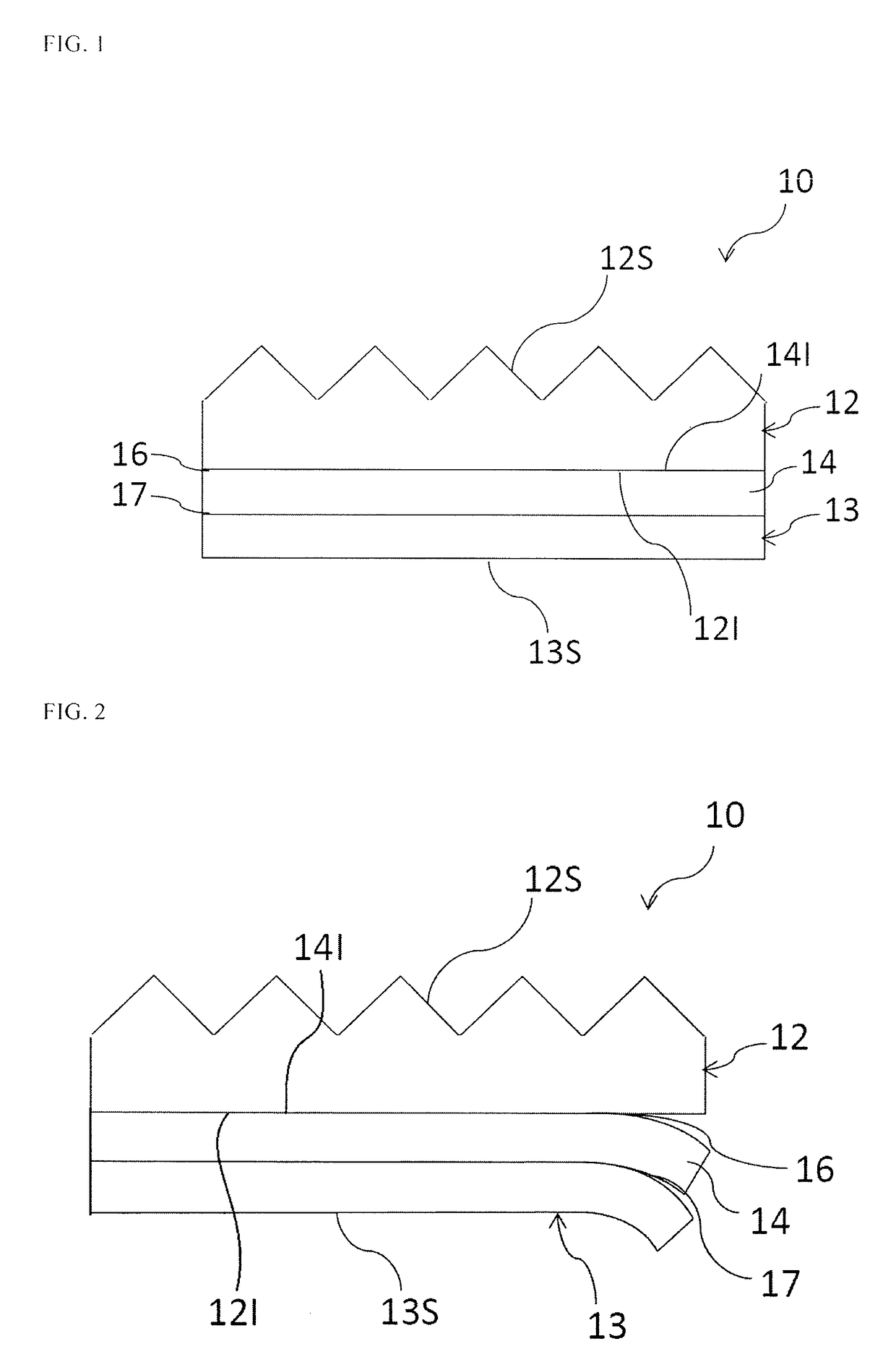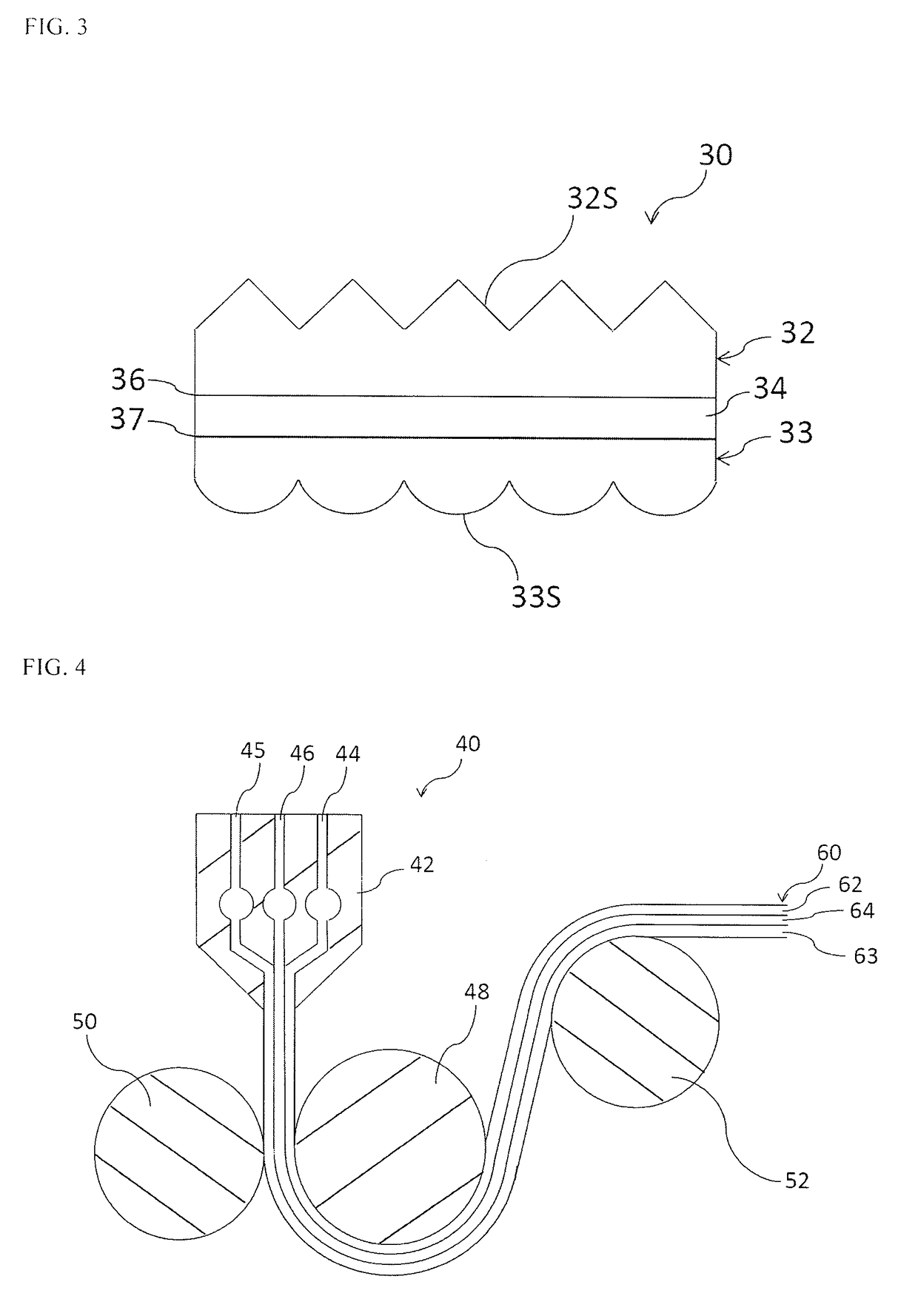Optical sheet and method for manufacturing same
a technology of optical sheets and fine grooves, applied in the field of optical sheets, can solve the problems of peel marks, thermoplastic resin is not sufficiently solidified and cooled, and the transfer property of the fine groove structure is likely to deteriorate, so as to prevent the cooling of resin, improve the transfer property of the fine groove structure, and enhance the transfer rate
- Summary
- Abstract
- Description
- Claims
- Application Information
AI Technical Summary
Benefits of technology
Problems solved by technology
Method used
Image
Examples
example 1
[0092]In Example 1, lupilon S-3000N (aromatic polycarbonate; Tg: 145° C.) from Mitsubishi Engineering-Plastics Corporation was used as a polycarbonate resin while an amorphous polyamide resin Grilamid TR XE 3805 (Tg: 153° C.) from EMS was used as a polyamide resin. The amorphous polyamide resin was plasticized by a 75 mmφ vent-type single-screw extruder while the polycarbonate resin was plasticized by a 40 mmφ vent-type single-screw extruder and a 32 mmφ vent-type single-screw extruder, respectively, and laminated using a 800-mm-wide multi-manifold die (see die 42 in FIG. 4) set at 280° C. to be extruded as a sheet. The above-described laminated body was molded to make a layered structure of the polycarbonate resin I (32 mmφ vent-type single-screw extruder), the amorphous polyamide resin (75 mmφ vent-type single-screw extruder) and the polycarbonate resin II (40 mmφ vent-type single-screw extruder) sequentially from the upstream side. The sheet-like molten resin flowing out from the...
example 2
[0098]In Example 2, sheet forming was performed in exactly the same manner as Example 1 except that: the grade of the polycarbonate resin was changed to lupilon H-4000N from Mitsubishi Engineering-Plastics Corporation (a bisphenol A aromatic polycarbonate obtained by polymerizing bisphenol A and phosgene through interfacial polycondensation, with a viscosity average molecular weight [Mv] of about 15000 and Tg of 140° C.); the type of the polyamide resin was changed to a polyamide resin Grivory G-21 from EMS (an amorphous polyamide resin, a mixture of Nylon (registered trademark) 6T (hexamethylene diamine+terephthalic acid) and Nylon (registered trademark) 6I (hexamethylene diamine+isophthalic acid), and made amorphous owing to an increase in the randomness of the molecular structure of crystalline PA). Tg: 125° C.); the thickness of the polycarbonate resin layer I was changed to 75 μm; the thickness of the polyamide resin layer was changed to about 150 μm; and the metal pressing / coo...
example 3
[0102]In Example 3, a crystalline polyamide resin UBE Nylon 1030B from Ube Industries, Ltd. was used as the polyamide resin to mold a prism sheet with a thickness of about 75 μm. The primary molding conditions were generally the same as Example 1. The transfer rate of this prism sheet was 74%.
PUM
| Property | Measurement | Unit |
|---|---|---|
| thickness | aaaaa | aaaaa |
| glass transition temperature | aaaaa | aaaaa |
| thickness | aaaaa | aaaaa |
Abstract
Description
Claims
Application Information
 Login to View More
Login to View More - Generate Ideas
- Intellectual Property
- Life Sciences
- Materials
- Tech Scout
- Unparalleled Data Quality
- Higher Quality Content
- 60% Fewer Hallucinations
Browse by: Latest US Patents, China's latest patents, Technical Efficacy Thesaurus, Application Domain, Technology Topic, Popular Technical Reports.
© 2025 PatSnap. All rights reserved.Legal|Privacy policy|Modern Slavery Act Transparency Statement|Sitemap|About US| Contact US: help@patsnap.com



